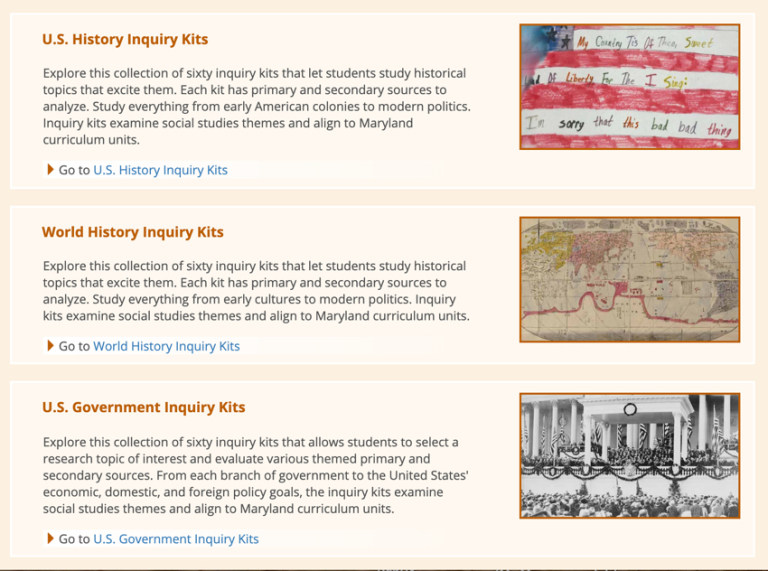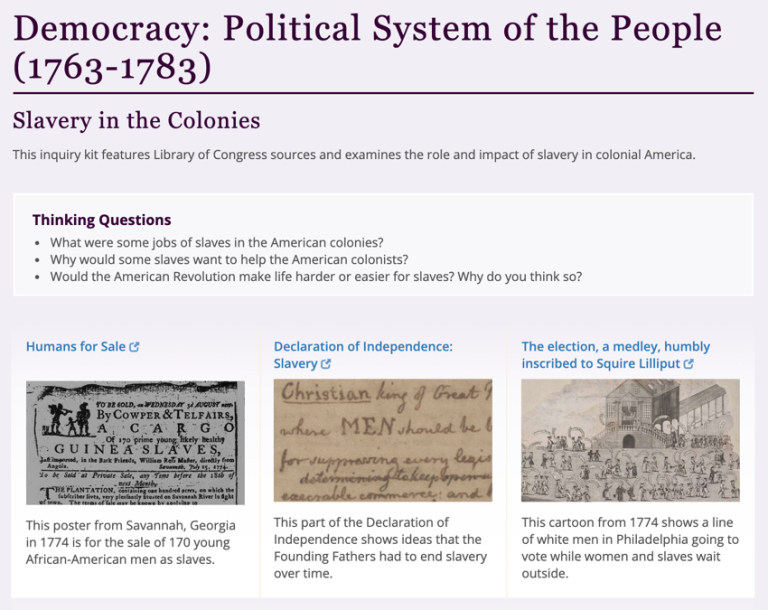TPS Inquiry Kits Just Became My New Fave for Primary Sources
Hypothetical.
You’re looking to create an Inquiry Design Model lesson and need some resources. Maybe you and your kids are getting ready to start a problem-based project. Perhaps you need some really good thinking or writing prompts. Or four or five engaging primary sources to add to your instructional unit.
Where do you go to find what you’re looking for? What’s your go to?
The Library of Congress, National Archives, and SHEG are my top three. But I’ve got a new favorite.
Developed by the folks at Maryland Public Television, the Maryland Department of Education, and the Maryland Humanities Council with funding from the Library of Congress Teaching with Primary Sources program, the recently created Social Studies Inquiry Kits give you access to great questions and powerful primary sources.
Each kit contains three guiding questions, five primary sources, and one secondary source. The Inquiry Kits are designed specifically to help as you plan your instruction. We know that it can be hard to work with primary sources in many of our classrooms. Sources are often not accessible, because of illegible text, high reading level, or simply a lack of interest on the part of students.
So how can Inquiry Kits help?
The Kits are organized to align with units in both US History and World History classes with another 60 lessons focused on government and civics. The five primary sources are mostly from the Library of Congress. It seems like many of the primary sources are images, maps, audio, or video to encourage accessibility no matter reading level.

When text-based sources are used, you’ll find transcriptions or read-aloud functions to help eliminate as many problems with comprehension as possible. You’ll also find links to Library of Congress primary source analysis worksheets to help with making sense of the evidence.
The three thinking questions in each of the 180 kits are perfect for helping support students as they analyze the documents. I love the questions and how you could use them to generate the essential and scaffolding questions in Inquiry Design Model lessons. They could also help you and students develop PBLs, exhibits, performances, documentaries, websites, or argumentative products.

You can also choose to simply use just one or two documents and one question as hook activities. You could also use all five sources to create primary sources sets or arrange them into a gallery walk. I like the idea of using the five sources to support additional student research into the topic.
I especially like the additional support materials. I especially like the leveled texts and additional questions that are included. You can find these by clicking the Teacher Resources for Inquiry Kits and scrolling down a bit to the ESOL Leveled Text and Thinking Questions section. You’ll find links to the 11 US units.

We all have our favorites when it comes to primary sources. You’re gonna need to add the TPS Inquiry Kits to your list.
cross posted at glennwiebe.org
Glenn Wiebe is an education and technology consultant with 15 years' experience teaching history and social studies. He is a curriculum consultant for ESSDACK, an educational service center in Hutchinson, Kansas, blogs frequently at History Tech and maintains Social Studies Central, a repository of resources targeted at K-12 educators. Visit glennwiebe.org to learn more about his speaking and presentation on education technology, innovative instruction and social studies.
Tools and ideas to transform education. Sign up below.
